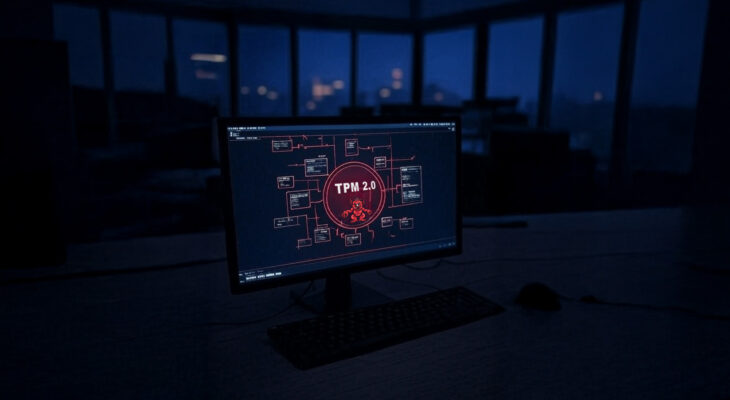If you’re using a newer Windows PC, it probably has a Trusted Platform Module (TPM) 2.0 chip inside. That’s’s a tiny piece of hardware which it supposed to keep your data – like passwords, encryption keys, and login info – safe by locking them away in a super-secure vault.
In fact, Microsoft loves TPM 2.0 so much that Windows 11 won’t even run without it.
Quis Custodiet Ipsos Custodes?
Who Watches the Watchers?
Here’s the thing: TPM 2.0 maybe guarding your data, but it could also be a shady way for companies or even governments to mess with your privacy.
Let’s break down why this chip raises so many red flags with privacy advocates and what you can do to protect yourself, without all the tech jargon usually involved in articles like this.
As always here at BTF, we’re highly skeptical but we’ll keep it fair.
Why TPM 2.0 Might Worry You
- Who’s Really in Charge of Your Data?
TPM 2.0 stores your sensitive stuff, but you might not be the one calling the shots. The chip is tied to your computer’s hardware or software, often controlled by the company that made your device or by other big tech players.
That means they could have access to your data, or at least possess the keys to unlock it. If they’re the ones holding the master key, how much control or ownership over your security and data do you really have?
- Your PC Could Be Tattling on You
TPM 2.0 has a feature called “remote attestation” that lets your computer prove it’s running the “right” software to someone else like a website or even a government.
While this sounds fine on the face of it, it could also be used to spy on what programs you’re using or force you to stick to “approved” apps.
Imagine your PC snitching to a company or government about what you’re doing. Creepy, right?
Well, this ability to tattle on your Wrongthink activities is already reserved by Microsoft in the Windows 11 End User License Agreement.
- Hackers Could Break In
TPM 2.0 is built to be tough, but it’s not perfect. There have been bugs in the past (like ROCA) that let hackers steal private data from these chips. If the chip’s firmware has a weak spot, someone could easily grab your private info.
And since the chip’s inner workings are often a mystery that’s strictly guarded by its manufacturers, it’s basically impossible to know whether it’s safe or not.
- Your Sensitive Data’s Stuck in One Place
Your TPM is glued to your computer. If you get a new PC or your old one breaks, moving your data or keys to another device is a pain, or sometimes just impossible. That’s a problem if you’re worried about what happens to your private info when you sell, repair, or trash your old PC or laptop.
Where exactly does that data go?
- It’s a Black Box
Most TPMs are made by companies that don’t tell you exactly how they work. Is your chip secretly sending info to the manufacturer? Are they collecting data about your PC?
Without clear answers, you’re forced to trust companies that DEFINITELY haven’t earned it, and that’s not a great feeling, is it?
- Big Brother Could Be Watching
Here’s the scariest part: TPM 2.0 could let governments or companies remote control your PC.
Imagine a government demanding access to your chip’s data for “security reasons,” or a company using it to lock you into their apps and block others.
It’s not hard to see how this could turn your computer into a tool for someone else’s agenda.
Need Help? Contact Us
But What You Can Do About It?
You don’t have to just accept these risks. Here are some practical ways to protect your privacy without needing a computer science degree.
We’re steering clear of big tech solutions like Microsoft’s tools and focusing on less mainstream options that give you more control.
- Take Charge of Your Own Security
Instead of letting your PC’s manufacturer control your TPM, you can actually try managing your data yourself. Free, open-source programs like `tpm2-tools` (available for Linux users, but usable with some effort on Windows) let you create and control your own encryption keys.
It’s a bit like locking your diary with a key only you have. But be warned; it does take some settingup. - Go for Transparent Tech
Some TPMs are “open-source,” meaning their code is public, and you can check how they work.
Look for devices or software that use open-source TPMs, like `swtpm`, which is a virtual TPM for testing or custom setups. These are less secretive than the chips from big manufacturers, so you’re not left guessing what’s going on. - Keep an Eye Out for Problems
TPM chips can have bugs, so stay alert. Check for updates to your computer’s firmware (the software inside the chip) through your device manufacturer’s website.
You can also follow tech news or groups like the Trusted Computing Group to hear about any new risks. Think of it like tracking manufacturer recalls on your car. - Speak Up for Your Rights
Push for laws that stop companies or governments from snooping through your TPM. Support groups like the Electronic Frontier Foundation (EFF), which fight for your digital privacy. Demand that companies explain what they’re doing with your TPM data.
Your voice matters. - Learn the Basics
You don’t need to be a tech wizard, but knowing a bit about TPM 2.0 helps.
Check out simple guides online. Try the Trusted Computing Group’s website or tech forums to understand how your chip works with your PC.
The more you know, the less you’re at the mercy of others.
What Do We Make Of It?
On the face of it TPM 2.0 sounds like a crucial component of your PC’s security, but it’s got a dark side.
It could let companies or governments peek into your data, lock you into their systems, or leave your info vulnerable if something goes wrong. By using open-source tools like `tpm2-tools`, choosing transparent tech like `swtpm`, and staying informed, you can fight back and keep your privacy intact.
But let’s be realistic: TPM 2.0 comes with strings attached, and you need to watch your back.
Stay sharp and don’t trust blindly.

